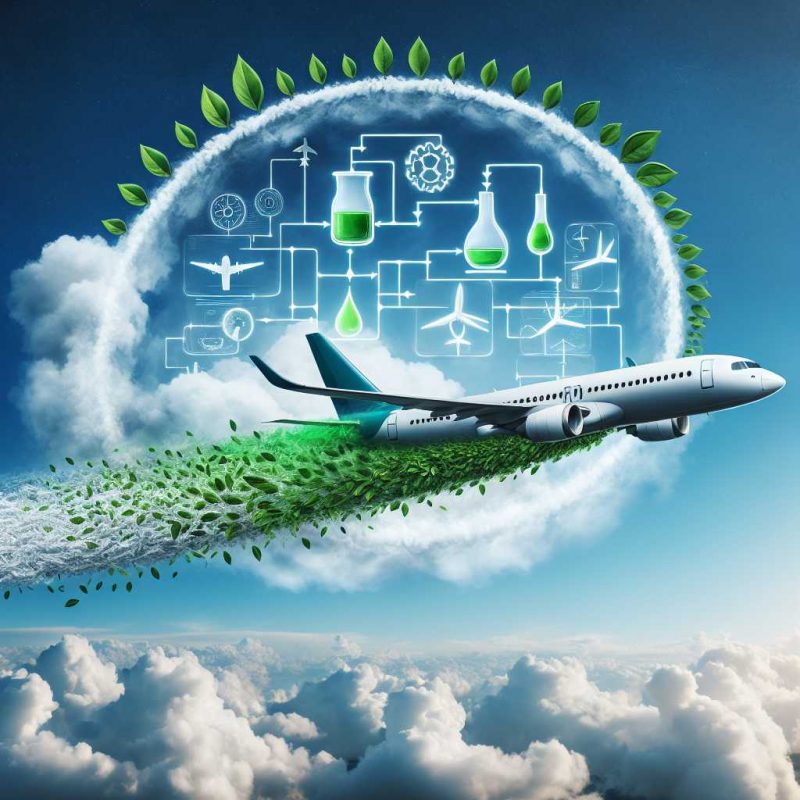The Dawn of Eco-Friendly Skies: Unveiling Sustainable Aviation Fuel
Imagine a world where our journeys through the skies are as gentle on the earth as a cloud floating across the horizon. That’s the vision driving the development of sustainable aviation fuel (SAF), the eco-friendly energy source that’s poised to revolutionize the way we fly. Let me unfold the story of this remarkable innovation that’s beginning to clear the air at 30,000 feet.
SAF is not your regular jet fuel; it’s a blend of renewable resources that can include used cooking oils, plant oils, waste fats, and even municipal waste. Unlike fossil fuels, these materials have already done their time in the carbon cycle, meaning they don’t add new carbon dioxide to the atmosphere when burned.
- SAFs are made from renewable resources, reducing dependence on traditional fossil fuels.
- They produce fewer air pollutants, making our skies cleaner.
- Using SAF can result in a significant reduction in greenhouse gas emissions over the lifecycle of the fuel compared to conventional jet fuel.
Now, for the magic to happen, these resources undergo a process called ‘hydroprocessing’ which turns them into jet fuel that’s ready to power our adventures across the globe. What’s truly enchanting is that SAF can be used in existing aircraft without the need for any special modifications. It’s like giving our planes a green makeover without changing their style!
The impact of SAF is not a tale of the distant future; it’s unfolding as we speak. Let me share a quick snapshot:
| Airline | SAF Initiative |
|---|---|
| Airline A | Began using SAF on selected flights in 2020 |
| Airline B | Committed to 10% SAF usage by 2030 |
| Airline C | Partnered with SAF producers for a steady supply |
And it’s not just the airlines that are getting on board. Airports around the world are gearing up their infrastructure to support this green revolution. Imagine tanks filled with golden, sustainable fuel, ready to whisk you away without leaving a heavy carbon footprint.
As we embark on this journey to greener horizons, it’s important to remember that every little step counts. The shift to SAF may seem like a drop in the ocean, but it’s the ripples from these drops that create the waves of change. So, the next time you look out of an airplane window, remember that the skies are becoming friendlier, not just for us, but for the planet too.
This is the tale of our eco-friendly skies, where SAF is the hero, and we’re all part of the story. The dawn of sustainable flight is here, and it’s a beautiful sight to behold.
Soaring to Greener Horizons: The Impact on Air Travel Emissions
Let’s spread our wings and explore how this green marvel, sustainable aviation fuel (SAF), is reducing the carbon tire marks we leave in the sky. Air travel emissions have long been a villain in the story of global warming, with airplanes emitting carbon dioxide (CO2) and other greenhouse gases that wrap the Earth a bit too snugly, leading to our planet’s fever.
But here’s a breath of fresh air: SAF swoops in like a superhero. It’s not just about replacing the old, it’s about transforming our skies into a canvas of blue and green. Every time a plane filled with SAF takes off, it’s a victory lap for our environment. Here’s how it works:
- SAF boasts a lower carbon footprint because it’s made from materials that are part of the Earth’s current carbon cycle.
- When SAF is produced, the process captures CO2 that would otherwise be released into the atmosphere, which is like putting a leash on a wild greenhouse gas.
- Using SAF can slash CO2 emissions by up to 80% over the fuel’s lifecycle compared to traditional jet fuel. That’s like replacing a gas-guzzling monster truck with a nimble electric scooter!
But the story doesn’t end there. SAF also puts a dent in emissions of other pollutants like sulfur oxides (SOx) and nitrogen oxides (NOx), which are like the sneaky sidekicks of CO2. This means cleaner air around airports and for those living under the flight paths.
Imagine this: we’re all aboard a flight, cruising above the clouds. A child next to you gazes out at the vast blue sky. “Is our plane hurting the Earth?” they ask. With SAF in the tanks, you can answer, “No, we’re flying on sunshine and recycled waste, keeping the sky as clean as it looks from up here.”
- SAF reduces the overall carbon emissions from air travel.
- It significantly lowers the release of other pollutants.
- It’s a solution that fits seamlessly with current aviation technology.
As we plot our course towards a greener future, SAF is our co-pilot, guiding us to a destination where clear skies are the norm, not a nostalgic memory. This isn’t just a flight of fancy; it’s a journey we’re already on, as airlines and airports commit to a future where our love for travel doesn’t have to be at odds with our love for the planet.
So, keep your tray tables stowed and your seat belts fastened, because we’re ascending to greener horizons where the impact of our air travel emissions is becoming as light as the clouds we soar through. Clearer skies are indeed ahead, and with SAF, we’re charting a course for a sustainable future in the wild blue yonder.
Revolutionary Refueling: Innovations in SAF Production and Use
As we continue our high-flying tale, let’s zoom in on a fascinating chapter: the revolutionary refueling that’s taking place with sustainable aviation fuel (SAF). This isn’t just a story about new fuel—it’s a narrative of innovation and determination to reshape the skies.
First up, the production of SAF is like a modern-day alchemy. Scientists and engineers have become the wizards of our time, turning what many would consider waste into a precious potion for flight. The process is a symphony of science and sustainability, blending creativity with technology.
Here’s a peek behind the curtain:
- Feedstocks like cooking oil and plant waste are collected, which might otherwise end up in landfills.
- These materials are then whisked away to a refinery, where they undergo a transformation, emerging as a shimmering, sustainable fuel.
- Innovative technologies such as catalytic hydrothermolysis are being explored to make SAF production even more efficient and cost-effective.
The use of SAF isn’t a distant dream—it’s happening now, and it’s as exciting as the first time humans took to the skies. Airplanes are being refueled with this green elixir, and with each flight, they’re writing history. But how is this sustainable marvel finding its way into the tanks of aircraft around the globe? Let’s consider the logistics:
- Airlines are partnering with biofuel companies to secure a steady flow of SAF.
- Airports are retrofitting their fueling infrastructure to accommodate the unique properties of SAF.
- Policymakers are offering incentives to encourage the use of SAF, making it an attractive option for the aviation industry.
Imagine a world where each journey you take contributes to the well-being of our planet. It’s not just a tale of convenience but a saga of conscious travel. Every gallon of SAF used is a small victory, a signal that we’re steering towards a future where travel and sustainability fly hand in hand.
| Airline | SAF Milestone |
|---|---|
| Airline D | First transatlantic flight powered partly by SAF |
| Airline E | Invested in sustainable fuel technology for regional aircraft |
| Airline F | Launched a customer carbon offset program with SAF options |
As we cast our eyes to the future, the story of aviation is being rewritten. It’s no longer a narrative of noisy, gas-guzzling jets but a vision of sleek, green machines soaring through the sky. The revolution of refueling is not just about what we put into our planes; it’s about the legacy we leave for future generations.
So, as you buckle up for your next flight, envision the SAF coursing through the engines, carrying you aloft on the wings of innovation. Together, let’s celebrate the pioneering spirit that’s propelling us towards a cleaner, brighter aviation era, one flight at a time.
Clearer Skies Ahead: The Future of Flight with Sustainable Aviation Fuel
As we cruise through this narrative of high-flying ambition, let’s gaze into the crystal ball and envisage the future of aviation, where sustainable aviation fuel (SAF) is the protagonist in a cleaner, greener chapter of air travel. The story ahead is as clear as the skies we aspire to protect; it’s a tale of innovation, progress, and a steadfast commitment to our planet.
In the future we’re dreaming of, every takeoff is a promise to the Earth—a vow to do better. The roar of jet engines will be the sound of progress, a symphony composed by the hum of SAF coursing through the heart of each airplane. Here’s a glimpse of what this utopia in the sky looks like:
- SAF becomes the norm, not the exception, with airports around the world fully equipped to dispense this eco-friendly fuel.
- Advances in technology make SAF more affordable and accessible, leading to widespread adoption and a significant decrease in aviation’s carbon footprint.
- New regulations and international agreements prioritize the use of SAF, making it an integral part of the global effort to combat climate change.
But how do we get from here to there? It’s a journey that requires tenacity, ingenuity, and a sprinkling of imagination. Picture this:
- Research and development in biofuel technology continue to break new ground, finding innovative ways to produce SAF from an even broader range of sources.
- Education and public awareness campaigns take flight, inspiring travelers and industry players alike to choose sustainable options.
- Collaboration between governments, industries, and environmental organizations soars to new heights, fueling a coordinated approach to sustainability in the skies.
The skies of tomorrow are bright with the promise of SAF. They whisper tales of a world where children grow up marveling at the beauty of our planet from above, without fear of harming it below. They speak of a time when the legacy we leave for future aviators is not one of challenges, but of solutions—of a sky that’s not only traveled but treasured.
| Innovation | Impact |
|---|---|
| SAF from Algae | Potential for high yield and minimal land use |
| Power-to-Liquid SAF | Uses renewable energy to create synthetic fuel |
| Carbon Capture SAF | Converts atmospheric CO2 into fuel, closing the carbon loop |
Let’s not forget that every story has its heroes, and in this one, it’s you and me—every passenger, pilot, policymaker, and person who believes in a future where flight and environmental stewardship go hand in hand. So, strap in and prepare for landing, because we’re approaching a world where the revolution of flight doesn’t just take us places—it takes us forward.
Clearer skies are on the horizon, and as we embrace the power of sustainable aviation fuel, we’re not just changing the way we fly; we’re changing the very skies we soar through. Here’s to the future of flight with SAF—may it be as endless and beautiful as the sky itself.











